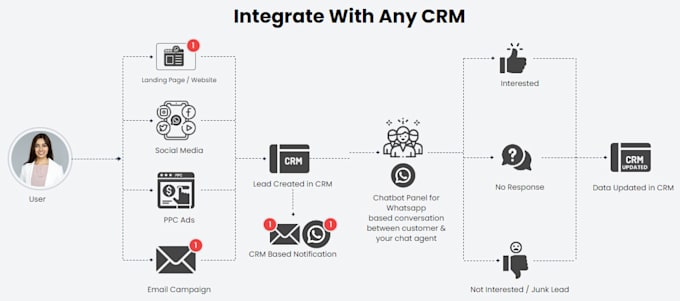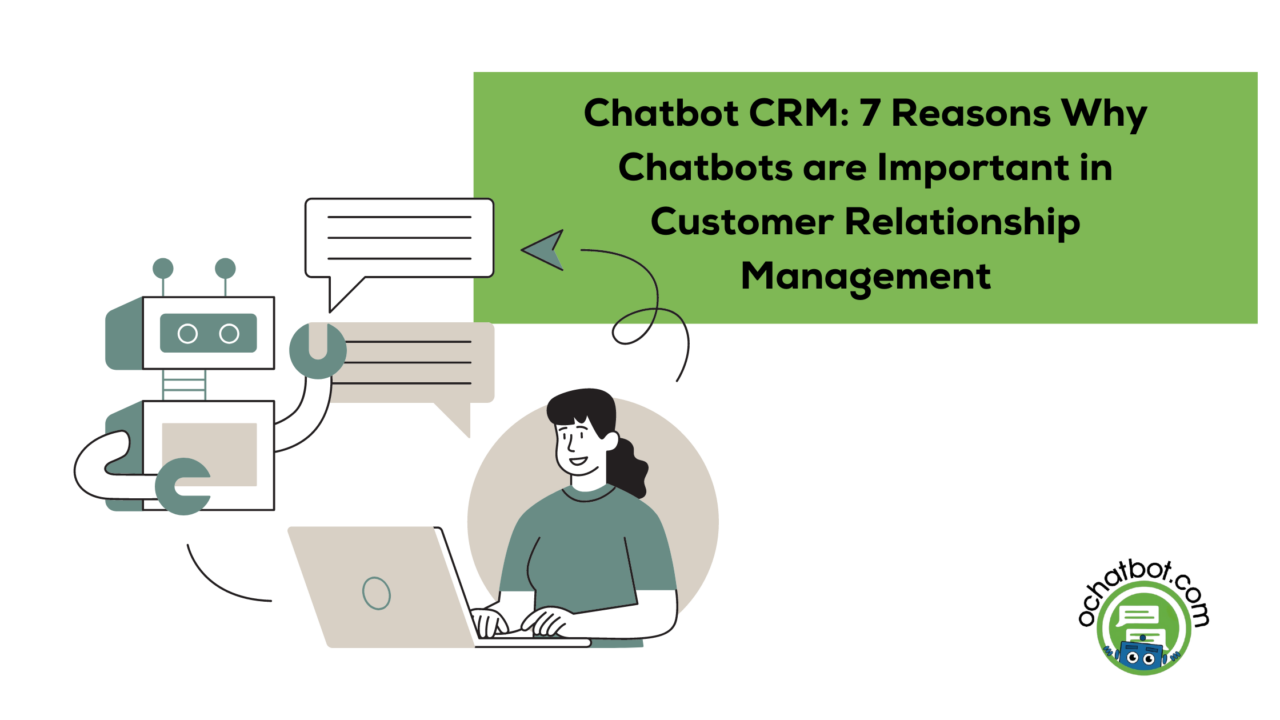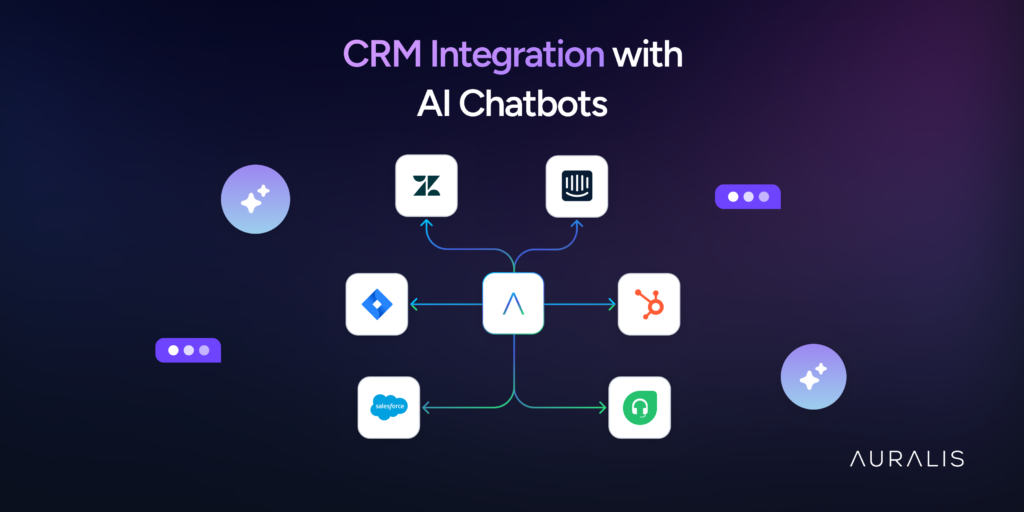
Supercharge Your Marketing: Mastering CRM & Chatbot Integration
In today’s fast-paced digital landscape, businesses are constantly seeking innovative ways to connect with customers, streamline operations, and boost their bottom line. One powerful combination that’s revolutionizing the marketing world is the integration of Customer Relationship Management (CRM) systems and chatbot technology. This dynamic duo offers a potent blend of personalized customer service, automated lead generation, and data-driven insights that can transform your marketing efforts. In this comprehensive guide, we’ll dive deep into the world of CRM and chatbot integration, exploring its benefits, implementation strategies, and best practices to help you unlock its full potential.
Understanding the Power of CRM and Chatbots
Before we delve into the specifics of integration, let’s establish a clear understanding of each component and how they contribute to a successful marketing strategy.
What is CRM?
CRM, or Customer Relationship Management, is more than just a software; it’s a philosophy centered on building and nurturing strong customer relationships. A CRM system acts as a central hub for all customer-related data, including contact information, purchase history, communication logs, and marketing interactions. This unified view of the customer empowers businesses to:
- Personalize marketing campaigns and offers
- Improve customer service and support
- Identify and nurture leads
- Track sales performance and forecast future trends
- Gain valuable insights into customer behavior
Essentially, CRM provides the foundation for a customer-centric approach, enabling businesses to understand their customers better and tailor their interactions accordingly.
What is a Chatbot?
A chatbot is a computer program designed to simulate a conversation with a human user, typically via text or voice. Chatbots are powered by artificial intelligence (AI) and natural language processing (NLP) technologies, allowing them to understand user queries, provide relevant information, and even complete tasks. They are increasingly used in marketing, sales, and customer service to:
- Provide instant customer support
- Qualify leads and capture contact information
- Answer frequently asked questions
- Guide users through the sales process
- Collect customer feedback
Chatbots offer 24/7 availability, instant responses, and the ability to handle multiple conversations simultaneously, making them a valuable asset for businesses looking to improve customer engagement and efficiency.
The Benefits of Integrating CRM and Chatbots
The true power of CRM and chatbots is unleashed when they are integrated. This integration allows businesses to leverage the strengths of both technologies to create a seamless and personalized customer experience. Here are some key benefits:
Enhanced Customer Service
Integrated chatbots can access customer data stored in the CRM system, enabling them to provide personalized support and resolve issues more efficiently. For example, a chatbot can identify a customer’s past purchases, address their specific concerns, and even proactively offer solutions based on their history. This level of personalization leads to increased customer satisfaction and loyalty.
Improved Lead Generation and Qualification
Chatbots can be deployed on websites and social media platforms to engage with potential leads, capture their contact information, and qualify them based on their needs and interests. This information is then automatically synced with the CRM system, allowing the sales team to prioritize and nurture the most promising leads. This streamlined process saves time and resources while increasing the chances of converting leads into customers.
Personalized Marketing Campaigns
With CRM and chatbot integration, businesses can create highly targeted marketing campaigns based on customer data and chatbot interactions. For instance, a chatbot can identify a customer’s product preferences, and this information can be used to send personalized email offers or product recommendations. This level of personalization increases the relevance of marketing messages, leading to higher engagement and conversion rates.
Data-Driven Insights
The integration of CRM and chatbots provides valuable data insights into customer behavior, preferences, and pain points. By analyzing chatbot conversations and CRM data, businesses can identify trends, understand customer needs, and optimize their marketing and sales strategies. This data-driven approach allows for continuous improvement and ensures that marketing efforts are aligned with customer needs.
Increased Efficiency and Automation
Integrating CRM and chatbots automates many time-consuming tasks, such as answering frequently asked questions, qualifying leads, and updating customer records. This automation frees up valuable time for marketing and sales teams, allowing them to focus on more strategic initiatives, such as building relationships and closing deals. This leads to improved productivity and a more efficient workflow.
Implementing CRM and Chatbot Integration: A Step-by-Step Guide
Integrating CRM and chatbots may seem daunting, but with a well-defined strategy and the right tools, it can be a smooth and rewarding process. Here’s a step-by-step guide to help you get started:
1. Define Your Goals and Objectives
Before you begin, clearly define your goals and objectives for integrating CRM and chatbots. What do you hope to achieve? Are you looking to improve customer service, generate more leads, or increase sales? Having clear goals will guide your implementation strategy and help you measure the success of your efforts.
2. Choose the Right CRM and Chatbot Platforms
Select CRM and chatbot platforms that meet your specific needs and requirements. Consider factors such as:
- Features: Ensure the platforms offer the features you need to achieve your goals, such as lead management, customer support, and marketing automation.
- Integration Capabilities: Choose platforms that seamlessly integrate with each other and other tools you use.
- Scalability: Select platforms that can grow with your business.
- Ease of Use: Opt for platforms that are user-friendly and easy to manage.
- Cost: Consider the pricing and licensing options of each platform.
Popular CRM platforms include Salesforce, HubSpot, and Zoho CRM. Popular chatbot platforms include ManyChat, Chatfuel, and Intercom.
3. Plan Your Integration Strategy
Develop a detailed plan for integrating your CRM and chatbot platforms. This plan should include:
- Data Mapping: Determine how data will be shared between the CRM and chatbot.
- Workflow Design: Map out the workflows that will be automated by the integration.
- Testing and Validation: Plan how you will test and validate the integration to ensure it works as expected.
4. Connect Your CRM and Chatbot Platforms
The process of connecting your CRM and chatbot platforms will vary depending on the specific platforms you choose. Most platforms offer built-in integration features or APIs that allow you to connect them. Follow the platform’s documentation and instructions to establish the connection.
5. Configure Your Chatbot
Configure your chatbot to access and utilize the data stored in your CRM system. This may involve creating custom chatbot flows, setting up data triggers, and defining how the chatbot will interact with customers. Make sure to personalize the chatbot’s responses based on customer data.
6. Test and Refine Your Integration
Thoroughly test your integration to ensure it functions correctly. Simulate various customer interactions and scenarios to identify any issues or bugs. Refine your integration based on your testing results. This may involve adjusting chatbot flows, modifying data mappings, or tweaking automation rules.
7. Train Your Team
Train your marketing, sales, and customer service teams on how to use the integrated CRM and chatbot platforms. Provide them with the knowledge and skills they need to effectively manage customer interactions, generate leads, and personalize marketing campaigns.
8. Monitor and Optimize
Continuously monitor the performance of your integrated CRM and chatbot platforms. Track key metrics, such as lead generation rates, conversion rates, and customer satisfaction scores. Analyze the data to identify areas for improvement and optimize your integration for maximum effectiveness.
Best Practices for CRM and Chatbot Integration
To maximize the benefits of CRM and chatbot integration, follow these best practices:
1. Personalize Every Interaction
Leverage customer data from your CRM to personalize every interaction with your chatbot. Use the customer’s name, purchase history, and preferences to tailor the chatbot’s responses and recommendations. This level of personalization fosters a more engaging and relevant customer experience.
2. Provide Seamless Handoffs to Human Agents
While chatbots can handle many tasks, there will be times when customers need to speak with a human agent. Ensure a seamless handoff process by allowing the chatbot to transfer the conversation to a live agent when necessary. Provide the agent with the customer’s conversation history and relevant CRM data to ensure a smooth transition.
3. Integrate Across Multiple Channels
Deploy your chatbot across multiple channels, such as your website, Facebook Messenger, and WhatsApp, to provide customers with convenient access to support and information. Ensure that the integration works seamlessly across all channels.
4. Continuously Improve Your Chatbot’s Training
Regularly review and update your chatbot’s training data to improve its ability to understand and respond to customer queries. Analyze chatbot conversations to identify areas where the chatbot is struggling and refine its responses accordingly. This continuous improvement will ensure that your chatbot provides accurate and helpful information.
5. Use Data to Drive Your Strategy
Leverage the data insights generated by your integrated CRM and chatbot platforms to drive your marketing and sales strategies. Analyze customer behavior, identify trends, and optimize your campaigns for maximum effectiveness. This data-driven approach will help you make informed decisions and achieve your business goals.
6. Ensure Data Security and Privacy
Protect customer data by implementing robust security measures and complying with all relevant data privacy regulations, such as GDPR and CCPA. Clearly communicate your data privacy practices to your customers and obtain their consent when necessary.
7. Measure and Track Key Metrics
Establish key performance indicators (KPIs) to measure the success of your CRM and chatbot integration. Track metrics such as lead generation rates, conversion rates, customer satisfaction scores, and chatbot conversation completion rates. Regularly review these metrics to assess your progress and identify areas for improvement.
Examples of Successful CRM and Chatbot Integration
Let’s look at some real-world examples of how businesses are leveraging CRM and chatbot integration to achieve remarkable results:
E-commerce: Personalized Product Recommendations
An e-commerce company integrated its CRM with a chatbot on its website. The chatbot greets returning customers by name and, based on their purchase history stored in the CRM, recommends relevant products. This personalized approach significantly increased click-through rates and sales conversions.
Healthcare: Appointment Scheduling and Patient Support
A healthcare provider integrated its CRM with a chatbot to automate appointment scheduling and provide patient support. The chatbot answers frequently asked questions, schedules appointments, and sends reminders, freeing up staff to focus on patient care. This integration improved patient satisfaction and reduced administrative overhead.
Financial Services: Lead Qualification and Customer Onboarding
A financial services company integrated its CRM with a chatbot to qualify leads and onboard new customers. The chatbot collects contact information, asks qualifying questions, and guides leads through the initial application process. This streamlined process significantly improved lead conversion rates and reduced the time it takes to onboard new customers.
Real Estate: Property Search and Lead Nurturing
A real estate agency integrated its CRM with a chatbot to assist potential homebuyers. The chatbot allows users to search for properties based on their preferences, collects contact information, and nurtures leads with personalized property recommendations and updates. This integration improved lead generation and increased sales.
The Future of CRM and Chatbot Integration
The integration of CRM and chatbots is an evolving field, and the future holds exciting possibilities. As AI and NLP technologies continue to advance, we can expect to see even more sophisticated and personalized customer experiences. Here are some trends to watch:
AI-Powered Chatbots
AI-powered chatbots will become even more intelligent and capable of understanding complex customer queries and providing more personalized responses. They will be able to learn from past interactions and adapt to changing customer needs.
Proactive Customer Engagement
Chatbots will proactively engage with customers, anticipating their needs and offering assistance before they even ask. For example, a chatbot could identify a customer who is experiencing a problem with their order and proactively offer support.
Seamless Omnichannel Experiences
Businesses will create truly seamless omnichannel experiences, allowing customers to interact with chatbots and human agents across multiple channels, such as websites, social media, and messaging apps, with a consistent and personalized experience.
Data-Driven Personalization
The integration of CRM and chatbots will enable businesses to create even more personalized customer experiences based on a deeper understanding of customer data and behavior. This will lead to increased customer engagement and loyalty.
Conclusion: Embrace the Power of Integration
CRM and chatbot integration is a powerful combination that can transform your marketing efforts, improve customer service, and drive business growth. By following the strategies and best practices outlined in this guide, you can unlock the full potential of this dynamic duo and create a customer-centric approach that sets your business apart. Embrace the power of integration, and prepare to revolutionize your customer relationships and achieve remarkable results.


